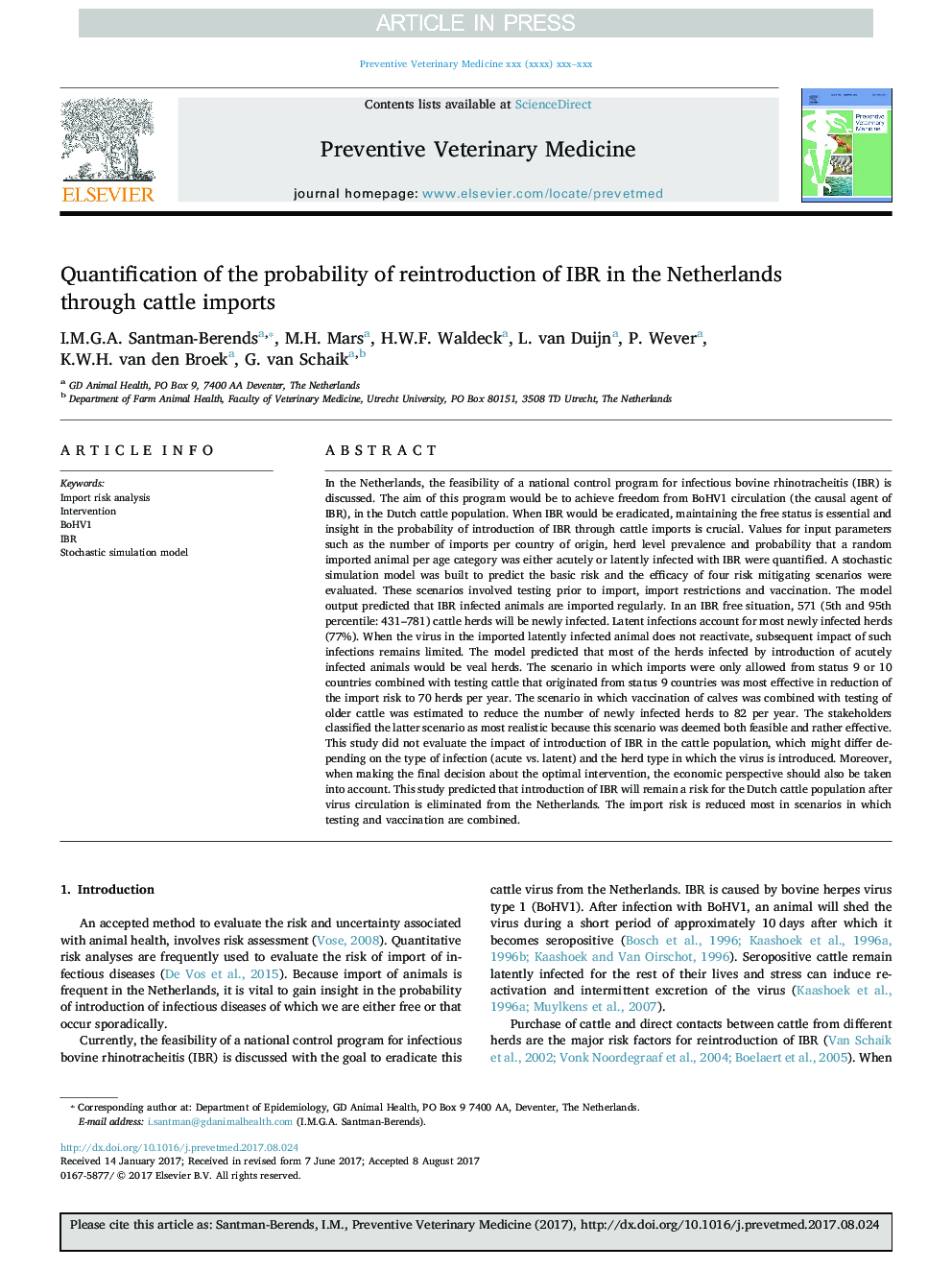| کد مقاله | کد نشریه | سال انتشار | مقاله انگلیسی | نسخه تمام متن |
|---|---|---|---|---|
| 8503584 | 1554140 | 2018 | 8 صفحه PDF | دانلود رایگان |
عنوان انگلیسی مقاله ISI
Quantification of the probability of reintroduction of IBR in the Netherlands through cattle imports
دانلود مقاله + سفارش ترجمه
دانلود مقاله ISI انگلیسی
رایگان برای ایرانیان
کلمات کلیدی
موضوعات مرتبط
علوم زیستی و بیوفناوری
علوم کشاورزی و بیولوژیک
علوم دامی و جانورشناسی
پیش نمایش صفحه اول مقاله

چکیده انگلیسی
In the Netherlands, the feasibility of a national control program for infectious bovine rhinotracheitis (IBR) is discussed. The aim of this program would be to achieve freedom from BoHV1 circulation (the causal agent of IBR), in the Dutch cattle population. When IBR would be eradicated, maintaining the free status is essential and insight in the probability of introduction of IBR through cattle imports is crucial. Values for input parameters such as the number of imports per country of origin, herd level prevalence and probability that a random imported animal per age category was either acutely or latently infected with IBR were quantified. A stochastic simulation model was built to predict the basic risk and the efficacy of four risk mitigating scenarios were evaluated. These scenarios involved testing prior to import, import restrictions and vaccination. The model output predicted that IBR infected animals are imported regularly. In an IBR free situation, 571 (5th and 95th percentile: 431-781) cattle herds will be newly infected. Latent infections account for most newly infected herds (77%). When the virus in the imported latently infected animal does not reactivate, subsequent impact of such infections remains limited. The model predicted that most of the herds infected by introduction of acutely infected animals would be veal herds. The scenario in which imports were only allowed from status 9 or 10 countries combined with testing cattle that originated from status 9 countries was most effective in reduction of the import risk to 70 herds per year. The scenario in which vaccination of calves was combined with testing of older cattle was estimated to reduce the number of newly infected herds to 82 per year. The stakeholders classified the latter scenario as most realistic because this scenario was deemed both feasible and rather effective. This study did not evaluate the impact of introduction of IBR in the cattle population, which might differ depending on the type of infection (acute vs. latent) and the herd type in which the virus is introduced. Moreover, when making the final decision about the optimal intervention, the economic perspective should also be taken into account. This study predicted that introduction of IBR will remain a risk for the Dutch cattle population after virus circulation is eliminated from the Netherlands. The import risk is reduced most in scenarios in which testing and vaccination are combined.
ناشر
Database: Elsevier - ScienceDirect (ساینس دایرکت)
Journal: Preventive Veterinary Medicine - Volume 150, 1 February 2018, Pages 168-175
Journal: Preventive Veterinary Medicine - Volume 150, 1 February 2018, Pages 168-175
نویسندگان
I.M.G.A. Santman-Berends, M.H. Mars, H.W.F. Waldeck, L. van Duijn, P. Wever, K.W.H. van den Broek, G. van Schaik,